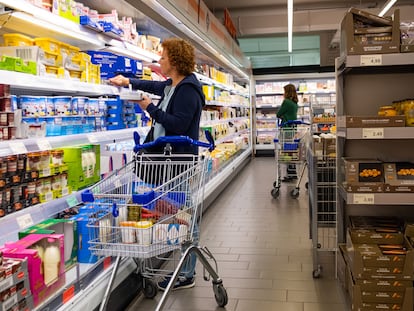Mario Lubetkin: ‘Never before has food security been such a focus of global attention’
The U.N.’s Food and Agriculture representative for Latin America and the Caribbean discusses new challenges in combating hunger across the region. ‘The world in 2015 is completely different from the world in 2023,’ he says


Climate change is wreaking havoc in the Brazilian Amazon. The drought plaguing the planet’s green lung is leaving entire populations isolated and immobilized due to low water levels, obstructing the main means of transportation for the region: rivers. The crisis threatens the survival of the tribes who live there, especially in terms of access to food.
This is one of the major problems that the United Nations Food and Agriculture Organization (FAO) seeks to combat with its new Plan for Food Security, Nutrition and Hunger Eradication in Latin America and the Caribbean. The initiative was first presented by the Community of Latin American and Caribbean States (CELAC) — an organization that brings together 33 states in the region — at its meeting in January of this year, and seeks to set new strategies and goals for 2024-2025, as it attempts to tackle current and future food challenges.
For Mario Lubetkin, the FAO’s Regional Director for Latin America and the Caribbean, the crisis is part of a new global landscape. “The world in 2015 is completely different from world in 2023, and our levels of response are much better, we have all matured,” he says, speaking to EL PAÍS in a meeting room on the fourth floor of the FAO building in Santiago, Chile, where the group’s regional headquarters is located. The Covid-19 pandemic and war have taught the organization a lot of new lessons. But the most remarkable thing, Lubetkin says, is that these tragedies have put the issue of food insecurity at the top of the world’s list of priorities.
Today, in addition to the CELAC initiative, Brazil’s President Luiz Inácio Lula da Silva is pushing a global hunger agenda from his new leadership role in the G20, the main forum for international economic cooperation. “According to the FAO, hunger affects 719 million people, and Lula used to say that the world had lost its propensity to be indignant at the situation and has normalized the unacceptable,” Lubetkin says. “But never before has food and nutritional security been at the center of global attention, at a level I would say is nearly on par with the climate crisis.”
The FAO has just released its latest Regional Food Security Outlook report for Latin America and the Caribbean. It is a 76-page document that gathers data and statistics from 2022 and provides an updated overview of the reality across the region.
Question. How has food security evolved in Latin America and the Caribbean?
Answer. For the first time, there are small signs of improvement in the hunger scenario. We tend to talk about the bad news, so it’s good to highlight when there’s good news. But we’re talking about a very low percentage: two and a half million people who rose out of hunger but there are still more than 37 million people who suffer hunger, which is absolutely tragic.
Q. Can we say there’s been a change in the trend?
A. We can’t say there’s been a change in trend, but there is hope that a path has been opened up.
Q. Does the situation differ between the countries of the region?
A. There are three regions within the region, and this has never been reflected in our numbers before. The scenario is better in South America, a food producing area; then there’s Central America, where the effects of climate change have been brutal, to the point that the numbers are similar to those of previous years, despite the great efforts that have been made. And this negative trend is also affecting the Caribbean.
Q. Why is the Caribbean falling behind?
A. There are a number of possible reasons, but without a doubt one of the most important is the lack of recovery in the tourism industry. People in the Caribbean used to buy food products, and they were able to buy quality products. But they’ve been unable to recover their main economic activity, tourism. Airlines went bankrupt, etc., etc. This has meant that, while they continue to buy almost 100% of the food they consume, they have less money, and when you have less money, you have to buy lesser quality foods, and that creates an increase in obesity. One of the areas in the region with the highest growth in obesity is the Caribbean.

Q. What is FAO’s approach to changing this reality?
A. Now the plan is to produce 25% [of their food] in the Caribbean, which is an extraordinary challenge and something that FAO will play a central role in supporting. South America has a great responsibility in this as well, as a result of the strength it has in terms of food-related issues.
Q. The pandemic and Russia’s war in Ukraine caused an increase in food prices. How has this scenario played out in Latin America and the Caribbean?
A. Prices have risen significantly, because the basic food costs in Latin America are more than in the rest of the world. If you look at the averages, in Brazil, [the average daily cost of food for one individual] is $3.08, but in the rest of Latin America we are at $4.08. That’s the highest in the world, where the world average is $3.66.
Q. What factors influence this higher cost?
A. There are hidden costs in the food system. The majority of these hidden costs, more than 70%, are connected to unhealthy diets, with ultra-processed foods, fats, sugar, which cause obesity and diseases that lead to losses in productive labor. And a fifth of the total costs are related to the environment, with greenhouse gas emissions, changes in land use and water use. All of this is what you supposedly don’t see in the immediate process.
Q. Although the report shows a slight decrease in the number of hungry people, there has been an increase in malnutrition and obesity. How is FAO facing this challenge?
A. The numbers are stark. According to data up to 2022, the rate of stunted growth in children under 5 years of age is 11.5%, which is 11 points above the world average. And the other significant statistic is that overweight children under the age of 5 has reached 8.6%, compared to a world average of 5.6%. This also has to do with cultural factors, with educational and health factors, of course. And the other issue is that adult obesity affects almost a quarter of the Latin American population, above the world average of 13.1%.
Sign up for our weekly newsletter to get more English-language news coverage from EL PAÍS USA Edition
Tu suscripción se está usando en otro dispositivo
¿Quieres añadir otro usuario a tu suscripción?
Si continúas leyendo en este dispositivo, no se podrá leer en el otro.
FlechaTu suscripción se está usando en otro dispositivo y solo puedes acceder a EL PAÍS desde un dispositivo a la vez.
Si quieres compartir tu cuenta, cambia tu suscripción a la modalidad Premium, así podrás añadir otro usuario. Cada uno accederá con su propia cuenta de email, lo que os permitirá personalizar vuestra experiencia en EL PAÍS.
¿Tienes una suscripción de empresa? Accede aquí para contratar más cuentas.
En el caso de no saber quién está usando tu cuenta, te recomendamos cambiar tu contraseña aquí.
Si decides continuar compartiendo tu cuenta, este mensaje se mostrará en tu dispositivo y en el de la otra persona que está usando tu cuenta de forma indefinida, afectando a tu experiencia de lectura. Puedes consultar aquí los términos y condiciones de la suscripción digital.
More information
Archived In
Últimas noticias
Welcome to the post-religion era: The idea of Christianity as the absolute truth has become obsolete
‘I thought you would like it’: The risky sexual practice popularized by TV shows and TikTok
The digitalization of tourism: ‘They promise experiences and gave us the worst possible one’
Mexican peso defies uncertainty with forecasts of a new period of stability in 2026
Most viewed
- Sinaloa Cartel war is taking its toll on Los Chapitos
- Oona Chaplin: ‘I told James Cameron that I was living in a treehouse and starting a permaculture project with a friend’
- Reinhard Genzel, Nobel laureate in physics: ‘One-minute videos will never give you the truth’
- Why the price of coffee has skyrocketed: from Brazilian plantations to specialty coffee houses
- Silver prices are going crazy: This is what’s fueling the rally










































